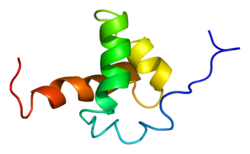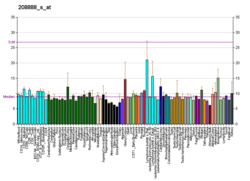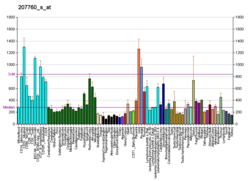Top Qs
Timeline
Chat
Perspective
Nuclear receptor co-repressor 2
Protein found in humans From Wikipedia, the free encyclopedia
Remove ads
The nuclear receptor co-repressor 2 (NCOR2) is a transcriptional coregulatory protein that contains several nuclear receptor-interacting domains. In addition, NCOR2 appears to recruit histone deacetylases to DNA promoter regions. Hence NCOR2 assists nuclear receptors in the down regulation of target gene expression.[5][6] NCOR2 is also referred to as a silencing mediator for retinoid or thyroid-hormone receptors (SMRT)[5] or T3 receptor-associating cofactor 1 (TRAC-1).[6]
Remove ads
Function
NCOR2/SMRT is a transcriptional coregulatory protein that contains several modulatory functional domains including multiple autonomous repression domains as well as two or three C-terminal nuclear receptor-interacting domains.[5] NCOR2/SMRT serves as a repressive coregulatory factor (corepressor) for multiple transcription factor pathways. In this regard, NCOR2/SMRT functions as a platform protein, facilitating the recruitment of histone deacetylases to the DNA promoters bound by its interacting transcription factors.[7]
Remove ads
Family
It is a member of the family of nuclear receptor corepressors; the other human protein that is a member of that family is Nuclear receptor co-repressor 1.[8]
Discovery
SMRT was initially cloned and characterized in the laboratory of Dr. Ronald M. Evans at the Salk Institute for Biological Studies.[5] In another early investigation into this molecule, similar findings were reported in a variant referred to as TRAC-1.[6]
Interactions
Nuclear receptor co-repressor 2 has been shown to interact with:
- AR[9][10][11]
- BCL6[12][13][14]
- C-Fos[15]
- C-jun[15]
- HDAC1[16][17]
- HDAC3[17][18][19][20][21][22][23]
- HDAC4[22][24]
- HDAC5[24]
- HDAC10[16]
- MeCP2[25]
- NR4A1[26]
- POU2F1[27]
- PPARD[28]
- PGR[29]
- PML[30][31]
- RBPJ[32][33]
- RELA[15][34]
- RUNX1T1[35][36]
- RARA[37][38]
- SIN3A[18][24]
- SNW1[39][40]
- SPEN[41]
- SRF[15]
- TBL1X[18][19][20][21]
- THRB[42][43][44]
- VDR[43][45]
- ZBTB16[12][35][38]
Remove ads
References
Further reading
External links
Wikiwand - on
Seamless Wikipedia browsing. On steroids.
Remove ads








